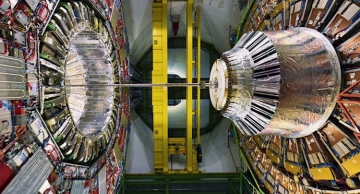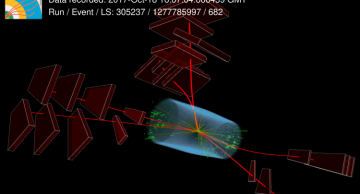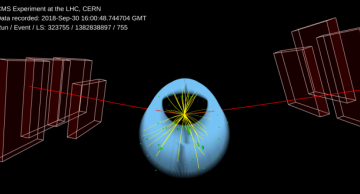In an extraordinary feat of precision physics, CMS measures the mass of the W boson, and finds it to be in good agreement with the prediction by the Standard Model of particle physics.
In the most precise measurement of its kind ever obtained at the…
A fundamental parameter of the Standard Model, the electroweak mixing angle plays a key role in the “Higgs mechanism”, when the W and Z gauge bosons get their masses through electroweak symmetry breaking. CMS has now reported a new measurement of…
CMS observed the simultaneous production of four top quarks, one of the rarest physics processes ever observed at the LHC, opening the door to detailed searches for physics beyond the Standard Model (SM).
Ever since its discovery at the…
On 5 July 2022, the LHC surpassed the previous energy limits of experimental particle physics, breaking its own record by achieving stable proton-proton collisions at a center-of-mass energy of √s = 13.6 TeV. This marked the start of Run 3, the…
Rare events, such as a total solar eclipse or a supernova explosion, are fascinating and stimulate our imagination. In addition, such events may lead to discoveries expanding our knowledge horizon. At the Large Hadron Collider (LHC), studies of…
Exactly ten years ago, on the 4th of July 2012, the ATLAS and CMS experiments announced the discovery of a new particle compatible with the long-sought Higgs boson.
This discovery takes us back to the events occurring in our early…
The biggest achievement of the LHC so far has been the observation of a Higgs boson in 2012. This is an outstanding confirmation of what today is the established theory that describes the fundamental interactions of particles, known as the standard…
Press Statement
The CMS collaboration has substantially improved the precision with which the top quark mass is measured. The latest result, a measurement of the top quark mass of 171.77 ± 0.38 GeV, was presented at CERN last week and estimates the…
The Higgs boson is peculiar in many respects. Like most other elementary particles, it is unstable and lives only for an extremely short time, 1.6 x 10-22 seconds, according to the established theory of particle physics (the standard model). Pretty…
High-energy particle accelerators are unique tools to study the structure of matter at the shortest distances. The most powerful accelerator today is the CERN Large Hadron Collider (LHC) that has so far collided beams of protons up to center-of-mass…
A new result released by the CMS Collaboration presents the first evidence of the Higgs boson interacting with the muon.
The standard model of particle physics describes all the known fundamental particles in the Universe. A mystery of the standard…











